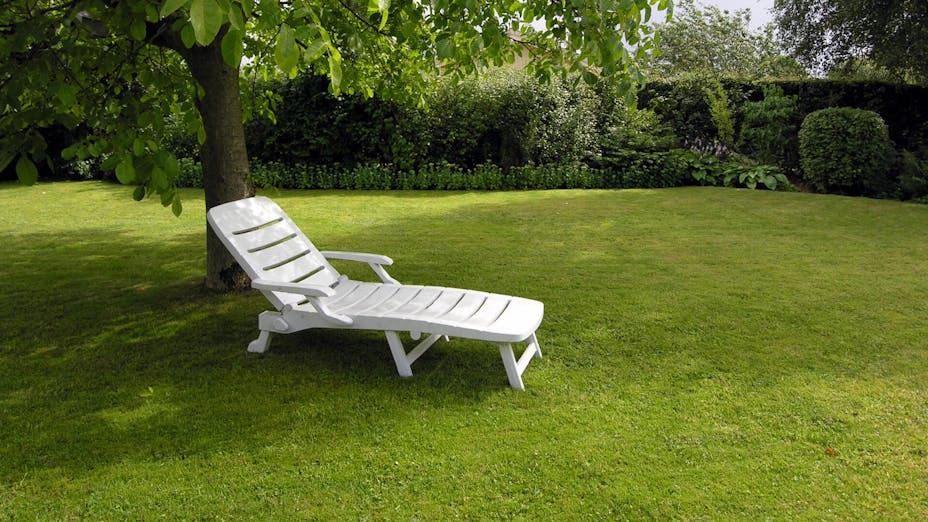
Lawn Moss Prevention
Removing and getting rid of moss in the lawn can be hard work so start by maintaining healthy grass with good maintenance methods.
If you knew that some of the things you do to your lawn are actually harming the grass and helping the moss I’m sure you would stop straight away if not sooner!
Mowing too close or scalping the lawn
Problem: Scalping or mowing the lawn too close removes so much leaf that the grass can’t function properly and manufacture food. It may also damage the growth crown of the grass resulting in slow recovery or death. This damage also clears a space for the moss to move in to your lawn.
Solution: Keep the lawn mowing height above ¾” for all lawns other than ornamental ones. At this height or above the grass plant has plenty of leaf to function properly. If you still scalp because of bumps either remove the bumps or set the mower even higher.
If moss is particularly bad raise your mowing height up to 2”. This will mean the grass gets lots of light on its leaves and puts the lower growing moss in the shade.
Make sure that when you mow, the cut grass clears the moss by at least ½”. If you chop the grass off so that there is none showing above the moss you are killing your lawn.
Finally, in some situations, you cannot mow too high!
Not mowing often enough
Problem: Infrequent grass cutting (every 2-3 weeks) means that you let the grass grow too long before you cut it. You then cut perhaps two thirds of the grass off each time you mow. This shocks the grass which then stunts growth temporarily allowing moss to take advantage.
Solution: Mow the grass regularly – weekly if possible. This will cause the grass to spread sideways creating a denser lawn thus preventing the moss from moving in. If you follow the ‘one third rule’ – never remove more than one third of the grass height in any one cut – you won’t go far wrong.
Lawn compaction or poor aeration
Problem: Lawn compaction is a lack of air spaces between the particles of soil which means the soil holds no air and therefore cannot hold or drain water. The result is an unhealthy, lifeless and slow growing lawn.
Solution: If this problem is localised (around clothes line or kids goal posts) spike regularly with a lawn spiker, aerator shoes and hollow tine fork. Sometimes it may be too compacted to get the fork in so wait until it softens with rain, spike it, then keep it watered and spiked so it’s always firmish but not hard. See How to Aerate the Lawn.
If the problem is over the entire lawn then read our section on Lawn Aeration & Equipment
Trees and Leaves
Problem: The tree competes with your lawn for water and light in the summer and then covers it with leaves in the autumn. Leaves on the lawn for anything more than a few days will weaken and even kill the grass at a time when the moss is most virulent.
Solution: There is no easy solution, just clear the leaves at least once a week. If it’s dry use the mower to suck up the leaves. Other alternatives are a blower or rake. Leaves will always be easier to clear if you have kept your grass at the right height. There is nothing harder than raking wet leaves in long wet grass.
Lawn Fertiliser
Problem: If the grass is struggling because of a poorly fed soil then it cannot fight off a moss attack. Moss will grow quite happily on your driveway as it is used to low nutrient levels; therefore a hungry lawn becomes quite inviting.
Solution: Give your lawn at least one good feed a year in the spring. If you have a moss problem consider an autumn fertiliser or a winter fertiliser with iron to keep nutrient levels at their optimum.
Grass Damage
Problem: Many lawns are play areas and also access areas for greenhouses, gardens and clothes lines. Excessive wear and tear or use when the lawn is weak can damage or even kill the grass.
Solution: Where possible rotate areas of use (just like the cricket wicket is rotated) so a worn area is not damaged to the point of no return. If this is not practical be prepared to re-seed the area before the moss and weeds take over. Some areas may become compacted due to excessive or long term use. See Lawn Repair & Renovation.
Excess Thatch
Problem: The build up of thatch above ½” deep will start to reduce fertiliser and water penetration to the grass roots. This makes life difficult for the grass whilst providing good conditions for the moss.
Solution: A thatch layer up to ¼” is fine and actually beneficial but as in most things, you can have too much of a good thing! If too much lawn thatch is present it’s going to need removing by scarifying the lawn. For small to medium sized lawns or for just localised raking the rolling lawn raker scarifier is an excellent tool that requires little effort. This will also remove the majority of your existing moss as well so it’s two birds with one stone! See Lawn Scarifying & Raking.